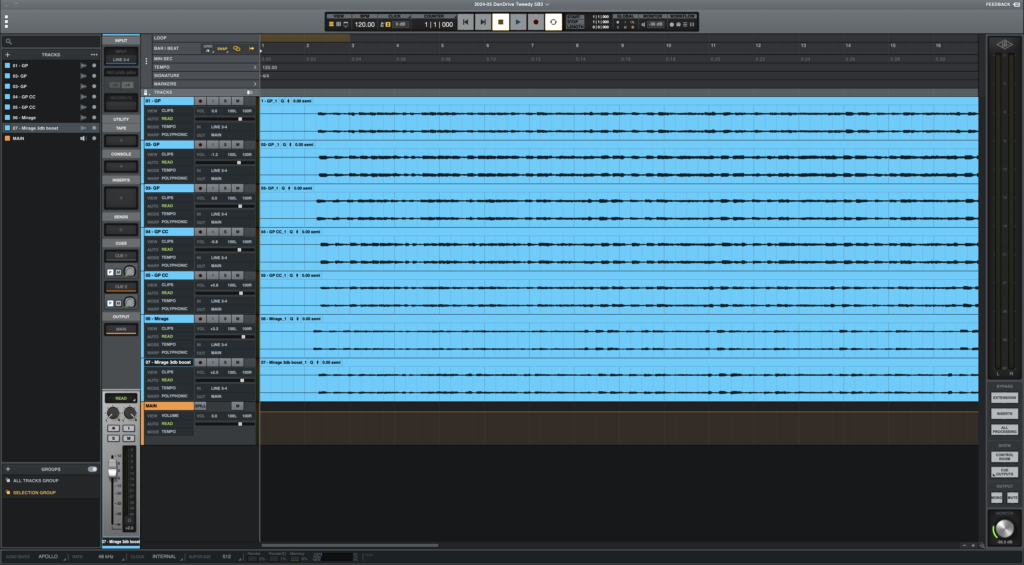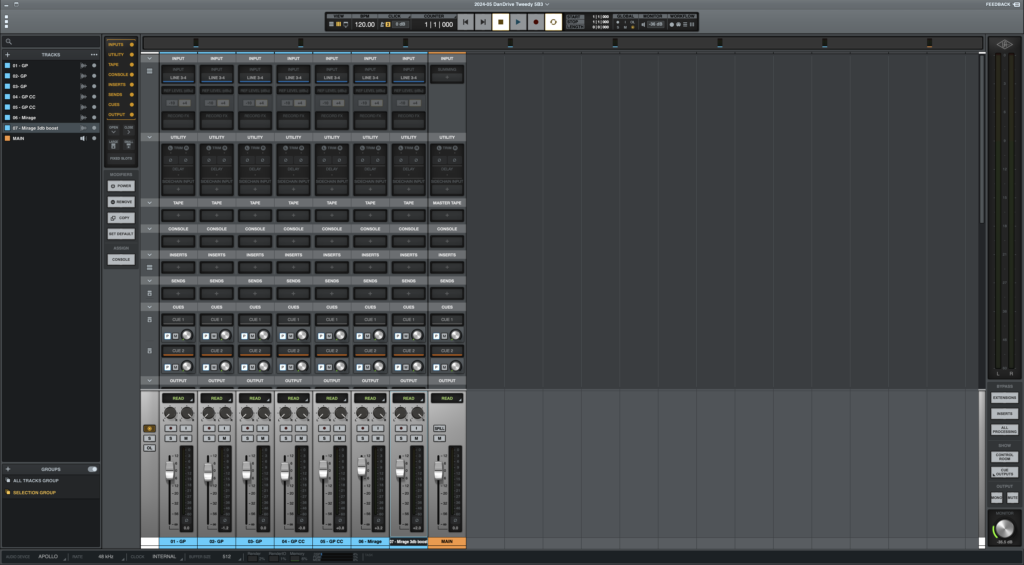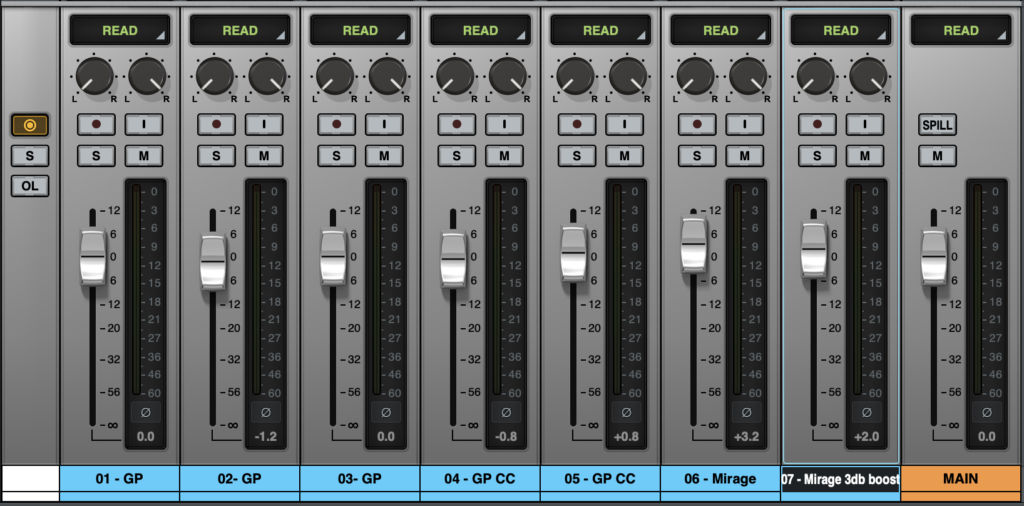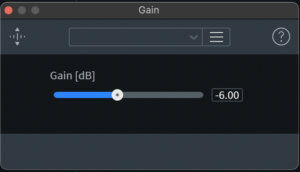I’m just prepping the audio for an upcoming blog post, and I thought it would useful to document how I go about it …
… because there’s a couple of gotchas that I’ve run into, that I don’t want to forget about.
And if I didn’t know this, maybe it’ll help someone else who needs to do the same thing? Or maybe someone who knows better will see this and leave a comment with helpful advice?
What Is “Level Matching”?
When I say “level matching”, I mean adjusting recorded audio so that each recorded track is roughly the same volume.
And when I say “roughly the same volume”, I mean that they all have the same “perceived volume” (measured in LUFS).
Why Am I Level-Matching My Tracks?
When I create audio demos for a blog post, I’m changing the signal chain as I go along. For example, I might be switching between guitars, or tweaking pedal or amp settings. These changes often also change how loud each individual recording is.
As a rough rule of thumb, if we hear two guitar tones at different volumes, our brains normally prefer the guitar tone that’s louder. “Louder is more good” and all that. I think that this innate human bias makes the audio demos less useful – unless I level-match the audio.
And then there’s the politeness reason too.
I don’t want my readers (listeners?) to have an unpleasant experience because there’s a sudden volume jump from one audio demo to the next. I think that’s a horrible thing to do to you.
Why “Perceived Volume”?
Honestly, if I had a reliable way to make each track have the same volume on my DAW’s meters (measured in dBa I think?), I’d go with that instead. I think that approach (known as RMS metering?) gives a more accurate representation of the impact that EQ tweaks have in my demos.
But – as I’ll explain shortly – I haven’t found a reliable way to do that, and doing it manually in LUNA has proven to be a bit of a pain.
I do have access to tools that will reliably normalise my audio demos using perceived volume. Going forward, this is what I’m going to use.
Audio Normalisation – Yet Another LUNA Missing Feature
As someone who primarily records live instruments (ie me playing my guitar), there’s a lot to like about LUNA. I love the ultra-low latency, how easy it makes it for me to work with my small collection of UAD plugins, and the overall workflow just seems to suit me quite well.
The further away I get from that sweet spot, though, the more it seems to be missing important features. LUNA’s no longer a new product; Universal Audio can’t credibly use that as an excuse any more (especially when you compare their progress to how rapidly Reaper evolves).
Today’s missing feature: audio normalisation.
I say it’s missing because I can’t find it. It may be there somewhere, but as the official LUNA documentation is currently unsearchable … 🤷♂️ People ask for it on the UAD forums, and official UAD accounts tell people to adjust track levels manually.
My read of it is that UAD don’t understand why people want a tool to automate this.
This is compounded by another problem in LUNA …
Tracks Exported From LUNA Do Not Have Volume Adjustments Applied
When I record audio demos for a blog post, I record all the demos inside a dedicated LUNA project. Each demo goes into its own track, and when I’m done, I export all the tracks out for further editing and upload.
Here’s what that looks like in LUNA.

This workflow is incredibly low-friction. I’m able to focus on capturing my experiences with the pedal I’m writing about, and not worry about the recording process.
The export process, though, has a bit of a flaw … at least for what I’m trying to do.
In that screenshot, if you zoom right in, you’ll see that I’ve made manual adjustments to the volume levels of most of the tracks. It might be a bit easier to see if I show you the exact same tracks in the Mix view:

Here’s a close-up of the volume faders at the bottom of the Mix view:

Hopefully, you can see the volume adjustments that I’ve made to each channel. The first track’s volume is left at 0, and I’ve adjusted most of the other tracks up or down to try and get them all sounding roughly the same volume as the first track does.
This manual process takes a bit of time – maybe as much as 15 minutes – and is definitely somewhat error-prone. But at least it’s possible to try, right?
Unfortunately, when I export these tracks, these volume adjustments are ignored. The resulting files on disk have the same volume that they had when all the volume sliders were at 0.
I’m embarrassed to say that I only realised this the other day. I’ve been using this process to normalise audio demo tracks for what – two years now? – and never noticed that the uploaded tracks didn’t include these volume changes.
Cue Captain Picard and Riker triple facepalm memes!
(As an aside, this makes me wonder … how do you create and export stems from LUNA …?)
Level-Matching Audio In iZotope RX Audio Editor
Fortunately, I have an old copy of iZotope’s RX Audio Editor. I’ve been using this for years in video production to clean up audio for my company’s YouTube channel. And one of the many things it can do is normalise audio.
And it has a handy batch processor mode too:

For some strange reason, RX Audio Editor won’t accept every MP3 that LUNA exports. It’ll accept some for batch processing, but not others. (The files literally won’t appear in the Input list.) Nothing else has any problems with MP3s created by LUNA, so I’m assuming it’s a weird bug in iZotope’s code.
The normalisation workflow ends up like this:
- export all tracks from LUNA as separate WAV files
- use RX Audio Editor’s batch processor to normalise the audio, and export as MP3s
- manually delete the WAV files to save on disk space (there’s no reason to keep them)
After some experimentation, I’ve put two steps into the batch processor.
The first step is the loudness normalisation module. I’ve gone with the “EBU R128” preset for this. I’ve had problems with some of the other presets compressing / limiting the final audio, which I absolutely don’t want. So far, “EBU R128” appears to be producing audio that isn’t compressed at all.

The audio that comes out of EBU R128 … I think it’s too loud for a solo instrument track. (You tell me if my audio demos need to be louder!) So the second (and final) step is a gain reduction module. I’m applying -6 dB, to bring the audio down closer to the volume of the original recorded track.

Is It Worth It?
If that seems like a lot of work … it’s still worth it.
First off, I need these audio demos for myself. Before I had these audio demos, I used to write about what I was hearing when I was sat in the playing position. I’ve learned that Jim Lill was right about one thing: to hear the actual tone, it’s important to listen to a recording of it.
When I’m playing guitar, I’m not sat in the ideal listening position (relative to my speakers). I’m hunched over the guitar, or I’m twiddling the controls on the amp, or I’m reaching over to try and dial the pedal in. This changes what I’m hearing … and sometimes those changes matter.
You – my reader (my listener?) – never get to hear that. You only get to hear the recording that I’ve made. So I think my articles are more relatable if I listen back to the audio demos and write about those.
Speaking of which … secondly, the audio demos serve as evidence for what I’ve written. You don’t have to simply trust my words: you can hear my results for yourself and come to your own conclusions.
Human hearing is also very subjective. If we both listened to the exact same sound, with all other variables eliminated, we’d still hear different things. My audio demos can’t change that, but at least they give you the chance to hear for yourself.
That’s important to me. It really helps me find the confidence to write new blog posts.
I’m well aware that many of my blog posts rank highly on Google because I’m one of the few people writing about gear (rather than making videos about gear). As such, I think it’s important to write with sensitivity. That starts with not writing anything that I wouldn’t say face-to-face to the manufacturer – and having the audio evidence to back up what I write.
(I don’t think I actually have any influence. I’m just trying to be reasonable and responsible.)
Final Thoughts
When I first started, I did some audio demos for the Marshall Origin amp posts. Both the mixes and the performances are … not great … but some folks did find them helpful in figuring out what kind of amp the Origin is and isn’t.
Now that I can record audio decently, maybe it’s time to revisit that …

9 Replies to “Studio Diary #43: How I Level-Match Demo Tracks In Universal Audio’s LUNA”